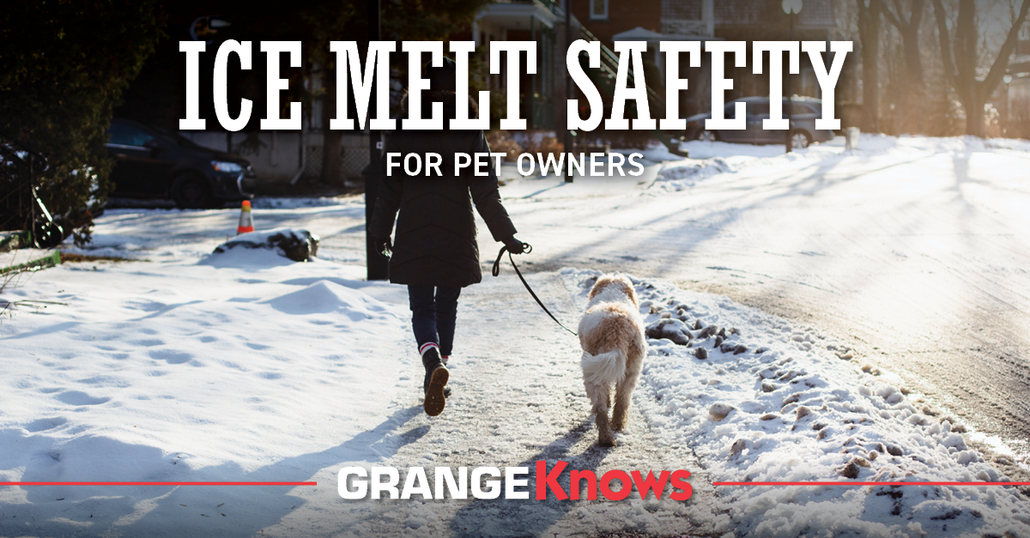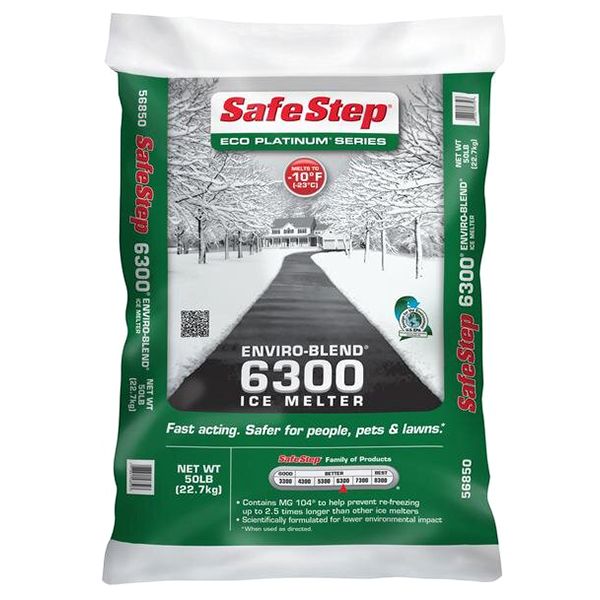
Ice Melt Safety for Pet Owners
Posted by Grange Co-op on 11th Jan 2022
The winter weather brings ice and snow that can lead to falls. Trying to shovel the ice off of steps and sidewalks is nearly impossible. The ice clings to the surface and doesn’t want to let go. That’s when people turn to deicers to make the ice melt. The problem with this is that most of these products are a threat to pet safety.
Deicers contain chemicals that are toxic to pets. They can get the deicer between their paw pads, causing their skin to dry out and crack, making it difficult to walk.
Another problem with using a deicer around pets is that many animals ingest the products. Some animals will eat anything that fits into their mouths. Others ingest the product by accident when they lick the ice or eat loose snow. It’s up to pet owners to read labels and understand the difference between these types of products and how to use them safely.
How an Ice Melter Works
Most deicers are made from different types of mineral salts. These products all work on the premise that adding salt lowers the freezing point of water.
The most common ingredient in household deicer is sodium chloride or rock salt. However, rock salt only makes ice melt at temperatures of 15°F or higher — it's ineffective once the temperatures drop below the 15-degree mark. Additionally, products containing rock salt will damage concrete due to the thawing and refreezing process. They are also toxic to plants and pets.
Potassium chloride ice melt works similarly to rock salt but is even less effective at low temperatures. While potassium chloride is one of the less toxic ingredients used to make the ice melt, the pet safety aspect only refers to causing less damage to pets’ paws. If they ingest the product, it can lead to serious health problems such as stomach upset, vomiting, and diarrhea.
Other salts like calcium chloride and magnesium chloride work much the same way. The biggest difference is the minimum temperature at which each product will effectively melt ice. Urea ice melt is less toxic than other deicers, but it can still be irritating to pets. Sometimes fertilizer deicers contain other chemical salts that are more toxic to pets than urea.
Applying deicers to ice doesn’t just cause it to melt and run away. These salt chemicals turn the ice into slush that then needs to be physically removed from the surface by shoveling or pushing it. Some deicers prevent the melted snow or ice from freezing again. Leaving the deicer in place gives pets access to the toxic effects every time they go outdoors. Remember, dogs especially love to play in the snow and will eat it. If they ingest deicer, it could have serious consequences.
In addition to deicers, people sometimes use sand, gravel, or kitty litter to create traction on the snow. This method might work once the bad weather has passed. It is safer for pets, but it doesn't provide a lasting solution that keeps driveways and walkways free of ice.
Assuring Pet Safety During Winter Weather
There are pet-safe deicers on the market that can put pet owners at ease. Sometimes a closer look at the label will deter anyone from using the deicer where they have kids or pets. Some products are marked as pet safe, but they advise against letting children around them. Any product that is hazardous to children should also be considered hazardous to pets!

Safe Step 6300 Enviro-Blend Ice Melt is safe for people, pets, and lawns. This deicer helps protect concrete surfaces and is less harmful to shoes and carpets when used as directed. Safe Step contains a powerful melting catalyst, MG 204, that helps prevent refreezing up to 2-1/2 times longer than other ice melt products. This results in the need for fewer applications. It even melts ice to 10°F/-23°C for optimal effectiveness in the harshest weather.
Protecting Your Dog from Deicers
Pet safety is an important issue for any pet owner. Those who have dogs must look beyond their own backyards to keep pets safe. Pets who walk on public walkways or go into their neighbor's yards might be exposed to chemical salts as well. Local governments and homes without pets are more likely to purchase a deicer based on cost than pet safety.
After taking dogs for walks or letting them outdoors on their own, dog parents should:
- Soak the dog’s paws in warm water and pat dry after they come back inside. (This applies to cats who go outdoors, too.)
- Examine the pet’s paws for cuts, signs of irritation, or sores regularly. Take pets to the vet at the first sign of trouble.
- Keep the fur between toe pads trimmed.
- Consider introducing the dog to dog boots to protect their feet while outdoors.
Shop for Pet Safety Products at Grange Co-op
At Grange Co-op, we know how important it is to keep your pet safe all year round. Getting the right information is as important as getting the best products to support your animals’ well-being. That’s why we’re here to answer your questions and make caring for your animal safe and easy.
For more information about our products or directions to one of our stores, contact us using our online form.
